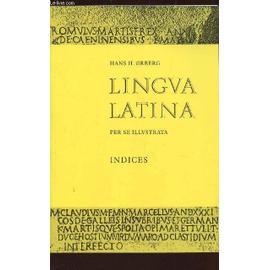


These annotated selections make Roma Aeterna useful both as the next step after Familia Romana and as a survey of Latin literature in its own right. The unadapted selections, which make up the majority of the text, are taken from Aulus Gellius, Ovid, Nepos, Sallust, and Horace. The prose selections are judiciously chosen and, in the first few chapters, gently adapted to provide students with a text that is authentically Latin and yet not difficult. The selection from Virgil is followed by Book One of Livy's engaging mythical history of Rome's foundation. A vivid description of the city's monuments precedes a prose retelling of the first four books of Virgil's Aeneid, with many of the most famous passages in their original verse form. Roma Aeterna (the main book of Pars II of the Lingua Latina per se illustrata series) introduces some of the most celebrated authors of Roman antiquity through the lens of Roman literature and mythology.

Categories: Foreign Language Study Roma Aeterna At the end of the volume there is a survey of inflexions, a Roman calendar, and alphabetical word-list and a grammatical index. Each chapter is divided into 3 or 4 lessons (lectiones) and consists of several text pages followed by a section on grammar, three exercises, and a list of new words. The 35 chapters form a sequence of scenes and incidents from the life of a Roman family in the second century A.D. Part I covers the essentials of Latin grammar and introduces a basic vocabulary of some 1600 words. In addition, factual information is given in the margin. Here, too, all new words and structures, if not immediately intelligible from the context, are explained by marginal notes or illustrations. While reading this story and learning facts about the Roman life and traditions, the students pick up the vocabulary and grammar that will enable them to go on, in Part II, to read a representative selection of Latin literature, both prose and poetry. To meet these demands the chapters of Lingva Latina I form a continuous narrative, a sort of Latin novel, which captivates the students so that they look forward to reading the continuation of the story. This demands a carefully graded text, but in order to make learning efficient the content should stimulate interest and curiosity and make it easy for the reader to visualise the scenes and situations described. In the text every sentence is intelligible per se, or self-explanatory, because the meaning and function of all new words and grammatical forms are made clear by the context in which they occur, or if necessary, by illustrations or marginal notes using vocabulary already learned. The direct method is based on the inductive principle of learning.

II: Roma Aeterna - the advanced course, with Indices covering both parts. It consists of two parts: I: Familia Romana - the fundamental or elementary course. The Latin course is written entirely in Latin. While reading this story and learning facts about the Roman life and traditions, the students pick up the vocabulary and grammar that will enable them to go on, in Part II, to read a representative selection of Latin literature, both prose.


 0 kommentar(er)
0 kommentar(er)
